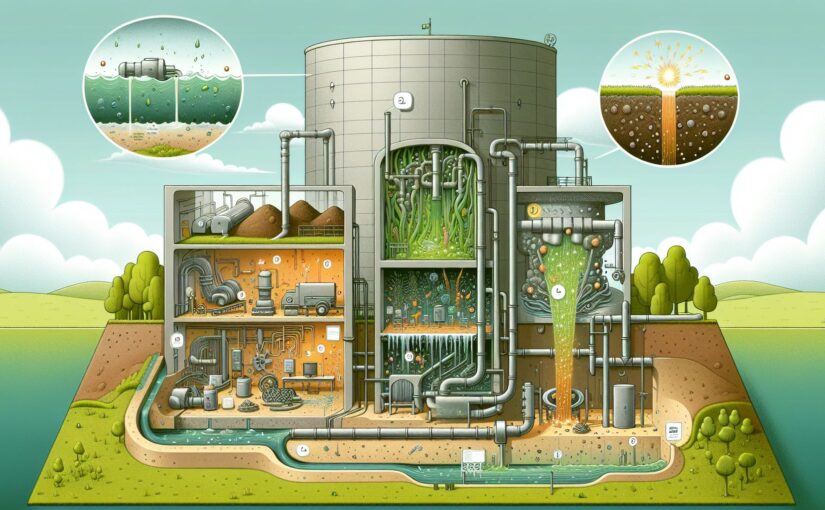In the current scenario of an energy-conscious world, the potential of microbiological communities in generating electricity from organic-rich wastewater faces unprecedented attention. Many recent technologies are seeking innovative ways to leverage the energy content of wastewater, preserve valuable water resources, and mitigate ecological footprints. One such novel technology that has garnered the attention of researchers globally is the concept of generating power from wastewater, through microbial fuel cells (MFCs).
Understanding the Process
Microbial fuel cells (MFCs) are bio-electrochemical devices that harness the power of respiring microbes to convert organic substrates directly into electrical energy. This principle of bioelectricity generation from wastewater is an incredibly intriguing research area due to two significant reasons. Firstly, it helps in dealing with the challenge of wastewater treatment. Secondly, it provides an opportunity for sustainable energy generation.
The fundamental principle here is that the organic matter in the wastewater serves as the fuel for the microbial communities. As these microbes metabolically break down the organic material, they release electrons, which are captured in the anode of the MFCs. These electrons then travel through a wire to the cathode, creating an electrical current.
The Potential and Advantages
Bioelectricity generation from wastewater offers several advantages over traditional wastewater treatment approaches. The method is remarkably energy-efficient, does not require the addition of chemical oxidants, and significantly reduces sludge production.
Besides treating wastewater, an MFC also produces electricity, thereby transforming a waste disposal problem into a potentially profit-making venture. The concept of generating energy from a waste product isn’t just an environmental win; it could also lead to significant cost savings for water treatment facilities.
However, it’s worth noting that while the idea of generating bioelectricity from wastewater is enticing, there are still various challenges to overcome. These include enhancing the efficiency of MFCs, scaling it up to an industrial level, and reducing the cost of electrode materials.
Further Research
The field of bioelectricity production from wastewater holds great potential. It has the double benefit of treating waste and producing renewable energy. While there are still many challenges to tackle and research to be done, the potential benefits make it a worthwhile venture.
Several researchers are focusing their studies on improving the design of MFCs to make them more efficient. For instance, the collaboration between experts at Spain’s University of Alcalá and U.S.-based Oregon State University is working towards the development of techniques to enhance power production in wastewater MFCs.
In conclusion, the sustainable and economic potentials of bioelectricity generation from wastewater make it a research area to watch out for in the coming years.
Sources
- Microbial Fuel Cells for Bioelectricity Generation from Waste to Resource
- Bioelectricity Generation from Wastewater
- Microbial Fuel Cells: A Current Overview
“`markdown
Bioelectricity Generation from Wastewater
In the current scenario of an energy-conscious world, the potential of microbiological communities in generating electricity from organic-rich wastewater faces unprecedented attention. Many recent technologies are seeking innovative ways to leverage the energy content of wastewater, preserve valuable water resources, and mitigate ecological footprints. One such novel technology that has garnered the attention of researchers globally is the concept of generating power from wastewater, through microbial fuel cells (MFCs).
Understanding the Process
Microbial fuel cells (MFCs) are bio-electrochemical devices that harness the power of respiring microbes to convert organic substrates directly into electrical energy. This principle of bioelectricity generation from wastewater is an incredibly intriguing research area due to two significant reasons. Firstly, it helps in dealing with the challenge of wastewater treatment. Secondly, it provides an opportunity for sustainable energy generation.
The fundamental principle here is that the organic matter in the wastewater serves as the fuel for the microbial communities. As these microbes metabolically break down the organic material, they release electrons, which are captured in the anode of the MFCs. These electrons then travel through a wire to the cathode, creating an electrical current.
The Potential and Advantages
Bioelectricity generation from wastewater offers several advantages over traditional wastewater treatment approaches. The method is remarkably energy-efficient, does not require the addition of chemical oxidants, and significantly reduces sludge production.
Besides treating wastewater, an MFC also produces electricity, thereby transforming a waste disposal problem into a potentially profit-making venture. The concept of generating energy from a waste product isn’t just an environmental win; it could also lead to significant cost savings for water treatment facilities.
However, it’s worth noting that while the idea of generating bioelectricity from wastewater is enticing, there are still various challenges to overcome. These include enhancing the efficiency of MFCs, scaling it up to an industrial level, and reducing the cost of electrode materials.
Further Research
The field of bioelectricity production from wastewater holds great potential. It has the double benefit of treating waste and producing renewable energy. While there are still many challenges to tackle and research to be done, the potential benefits make it a worthwhile venture.
Several researchers are focusing their studies on improving the design of MFCs to make them more efficient. For instance, the collaboration between experts at Spain’s University of Alcalá and U.S.-based Oregon State University is working towards the development of techniques to enhance power production in wastewater MFCs.
In conclusion, the sustainable and economic potentials of bioelectricity generation from wastewater make it a research area to watch out for in the coming years.
